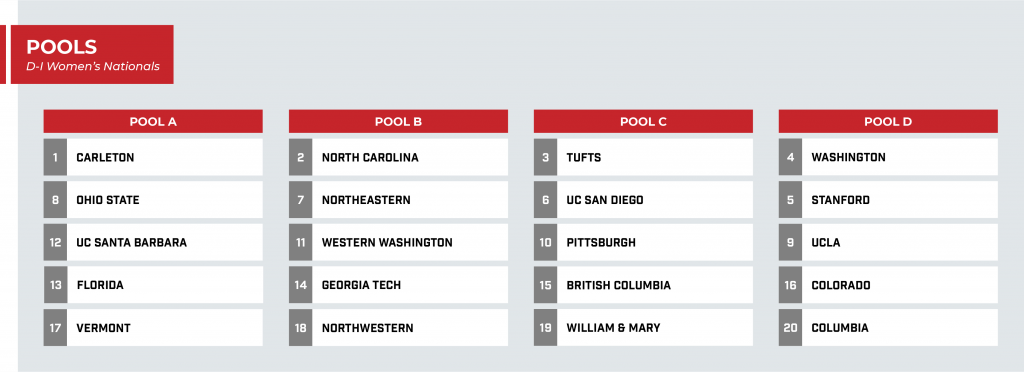It's Nationals time! Who will make the bracket?
June 5, 2020 by Daniel Prentice and Graham Gerhart in Opinion, Recap with 0 comments
The simulation engine used for this article was built by guest contributors Alex Trahey and Daniel Walton. This article would not have been possible without their effort and expertise.
The college postseason is perhaps the most exciting set of events in ultimate. A plethora of teams come together with equal opportunity to reach the same championship. While favorites make up the primary ingredient of the dish, the upsets, double game points, and comebacks add the seasoning that makes for a flavorful and satisfying meal. There’s not quite another event like it in our sport.
We didn’t want to live in a world with no college postseason, so we sat down and asked, “How could the 2020 College Series have gone down?” We took the rankings algorithm, adjusted slightly to reflect our staff’s opinion of teams, and added a pinch of randomness that comes with life, and simulated how each and every regional event could play out. There were some creative liberties and constraints applied (see “Methodology”) before we sent our writers to imagine the sets of events that could have led to our simulation’s results.
Previously, we shared the top five finishers in both the D-I men’s and D-I women’s divisions, along with a narrative story of how things might have played out, and every game from every regional championship.
Now, it’s on to Nationals! We plotted the seeding, tuned our ratings and model, and ran the numbers again. Then we set about creating a story to tie together the numbers. So what happened in our Nationals pool play?
Methodology
To simulate an ultimate game, we determined the outcome of successive points by flipping a weighted coin. One coin is used for when Team A starts the point on offense and a second coin (with a different weight) is used for when Team B starts the point on offense. If the coin comes up heads, Team A scores the point; if it comes up tails, Team B scores.
For simplicity, games were played hard to 15 points — no timed round constraints, no win by two.1 The probability of heads for each coin is determined by the power rating difference between the two teams. We created a model based on results from the 2019 college postseason — and some minor human input from our staff at the start of the process — to assume how likely a team is to win a game and what the expected score is based on their power rating differential with their opponent. We use this empirical relationship to translate power rating differential — teams’ power ratings are based on 2020 regular season results with some small adjustments given the shortened season — into probabilities for the weighted coins. This approach was used previously to simulate the outcome of the 2019 College Championships. For more background on how games are simulated, check out this article.
To simplify: using past postseason data, we calculated how likely a team is to win a game against an opponent with a different rating. Then we took this season’s data and rolled the dice to see which teams would win.
There are some additional elements to note:
- BYU is included because we thought that’d be more interesting.
- We tuned our model to account for how teams behave during blowouts, decreasing the likelihood of massive margins.
- Writers did not influence the simulation’s results.
- Power Rankings are from our final update of the regular season and do not reflect any simulated results that impacted bid movement.
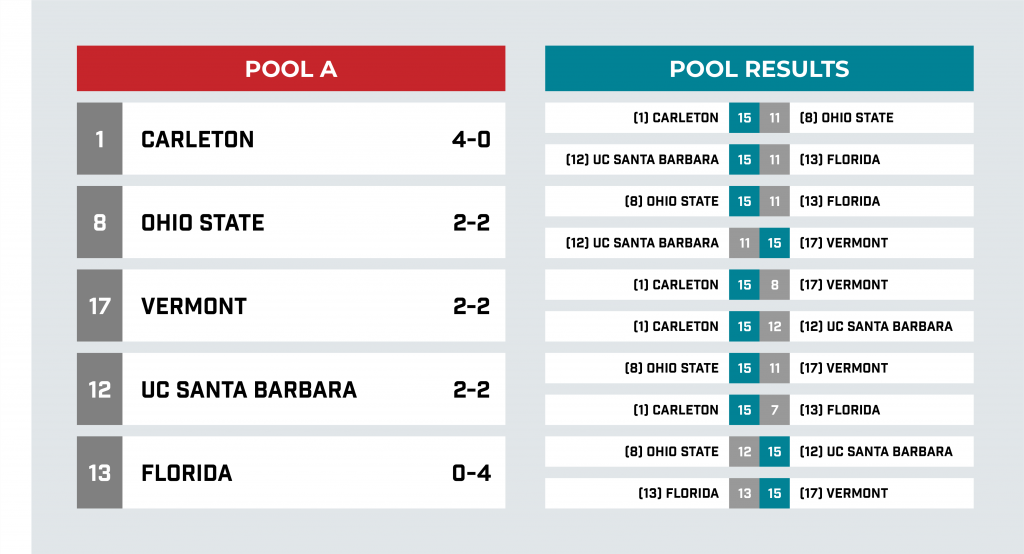
The tournament’s top seed, Carleton, won the pool as expected, but Pool A lived up to its exciting potential. Ohio State, Vermont, and UCSB all ended up at 2-2, forcing a three-way goal differential tiebreaker to send Ohio State and Vermont into prequarters.
Carleton went 4-0, but they weren’t nearly as dominant as expected, either. After taking an 8-2 lead into halftime of their opening game against Ohio State, Carleton let their opponents hang around and claw back to within 13-10. The lead was never in real danger, and they ended up winning 15-11, but the sloppy second half play of their O-line was a harbinger of future struggles.
They ended day one by building another huge early lead against Vermont, scoring nine straight goals after surrendering a hold on the first. But again, the O-line ran into a second half slump and surrendered four straight breaks right before the end of the game to win 15-7.
Giving up breaks in a blowout win doesn’t mean much, but the real scare for Carleton came on day two. Instead of a second half lull, the O-line could not get anything going against UC Santa Barbara early. Karen Ehrhart and Kate Lanier looked totally out of sync as the Jasmine Childress-led D-line for UCSB forced turnover after turnover. UCSB held their largest lead at 11-5, easily Carleton’s biggest deficit of the season. But they would not blink.
Carleton held UCSB to just a single goal the rest of the game. Syzygy’s Nariah Sims somehow managed to outshine Childress’ first half performance by logging four blocks, three goals, and an assist down the stretch. Carleton roared back to win 15-12 and locked up first place in the pool.
UCSB really could have used the win, after dropping their game to Vermont earlier in the weekend. But it wasn’t to be, bringing them to a meager 1-2, though they still controlled their own destiny. Their final game came against Ohio State. The Burning Skirts needed not only to win against OSU but win by enough goals to make up for their four goal defeat to Vermont. Any win would be enough to advance if Florida could knock Vermont in the final game of pool play, but that was unlikely given how the two had played to that point.
In tragic poetic fashion, UCSB did get the win over Ohio State as Childress and Kaitlyn Weaver were able to outduel the OSU duo of Cara Sieber and Emily Barrett. But the game was tight the whole way. Ohio State never let Santa Barbara pull away, despite having the lead just once all game at 2-1. The final score of 15-13 in favor of Santa Barbara left them in third place out of the three 2-2 teams.
The final bracket spot of the pool would be determined by its final game. At 0-3, Florida was playing for pride while Vermont was coming off of more than four hours of bye rounds after their 15-11 defeat to Ohio State in the first round of the day. Vermont showed a little bit of their inexperience at this level against OSU, failing to adjust defensively once Fever had figured out their zone. But against Florida, they showed the fight and resolve of a Nationals regular.
Florida fought valiantly, despite not having anything to play for other than not finishing last in the pool. Gabby Krajniak was a problem all game long, finishing with seven assists and a goal. But Vermont’s young lineup had just enough in them to outlast Krajniak and Florida. Kennedy McCarthy had her best game of the weekend, notching five goals and a pair of assists as Florida could not come up with a way to contain her deep.
Vermont edged out Florida 15-13 to claim the final bracket berth from Pool A, breaking UCSB’s hearts, and pushing Ohio State up into second place.
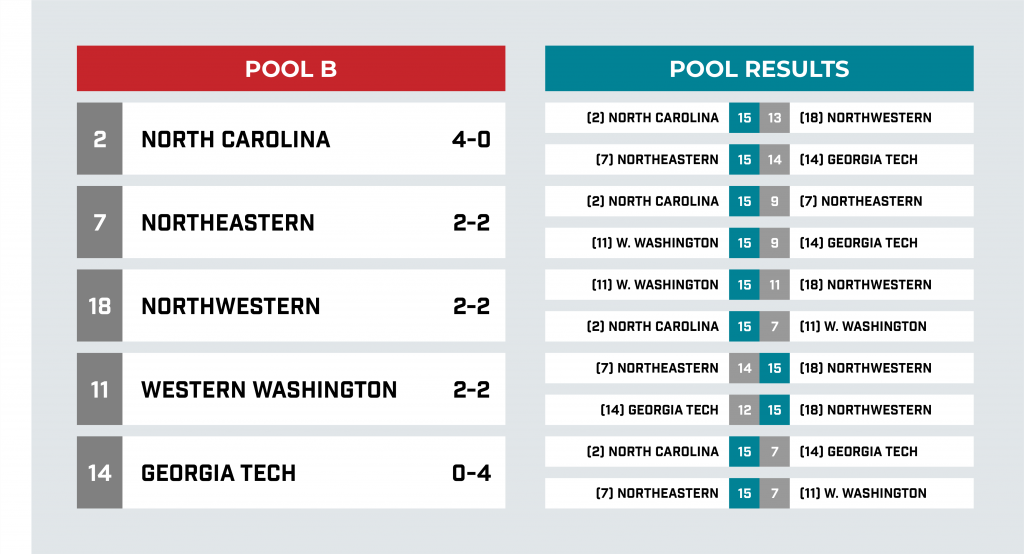
Pool B included some of the tournament’s biggest upsets, and some near-misses that could have thrown things into chaos beyond the three-way tie that the pool ended in. By the time the final bell rung, it was the Pool of the North, as North Carolina, Northeastern, and Northwestern advanced, despite the best efforts of Western Washington and Georgia Tech.
Both close calls came in the tournament’s opening round. North Carolina faced their stiffest test, escaping a late run from Northwestern. We waited until Atlantic Coast Regionals to see Anne Worth take the field, and while she showed few signs of rust that weekend, she looked a bit off-kilter on her first few offensive points. But Ella Juengst, Bridget Mizener, and Tyler Smith offered enough firepower to keep UNC in front, even if they did it in inefficient fashion. Eventually, they accrued a 10-4 lead before Northwestern reduced their unforced errors and UNC started missing the tight window plays they had been hitting earlier. Gung Ho steadily climbed back into the game, lurching forward with occasional breaks that got them as close as 14-13. But before they could tie it up, the favorite ended the contest with a quick strike score from Tyler Smith to Anne Worth, and their star’s speedy strides were exemplary of how the rest of UNC’s day went.
A field over, Northeastern Valkyries had their hands full with a noisy Georgia Tech team that was playing with a chip on their shoulder. In a game loaded with turnovers of every sort, neither team led by more than two and nearly half the scores (12 of 29) were scored by the defenses. Ari Nelson and Clara Stewart remained key pieces of the Northeastern attack, while Jenny Choi, Ollie Peterson, and Chupzi Lema were at the center of Georgia Tech’s efforts. A string of three breaks by Wreck, powered by blocks from Dana Rose and Samantha Loop, earned them the upper hand, and Loop zipped a forehand on an up-line away to Lema to break for half, up 8-7. A late run from Northeastern, thanks in part to Anna Cullen’s block-earning work in the cup that they switched to, put them up 14-12. Wreck forced double game point by capitalizing on the Valkyries’ over-aggressive deep game, but couldn’t stop Stewart in isolation on the next point, setting up Sophie Shen to hit Lamia Farah for a toe-in goal that, after a dramatic pause where all eyes went to the observer, was confirmed in.
After a status quo Friday, Saturday took a different turn thanks to the stellar play of Northwestern. Another rough morning for Northeastern turned into a great day for the directional sisters, who were happy to be the benefactors of a totally disconnected Valkyrie huck attack. No one in the pool had figured out how to put the brakes on Sara Gnolek, who looked vengeful after last year’s hobbled performance at Nationals, and she had played well even in their Friday losses. She was dialed in on both sides, punctuated by a half-ending huck to Sydney Steltzer — one of Steltzer’s five goals in the game — for an 8-4 Gung Ho lead. Northeastern shoved their way back into the game in the second half but could never seize the lead. They forced double game point, but couldn’t stop Rey Tang from getting upline and hitting Talia Willmert with a huck to close it 15-14, marking the pool’s first upset.
For the encore, Northwestern handled Georgia Tech in the noon round, as some rain and light wind aided their zone defense. Gnolek was at the center of that, too, with multiple blocks in the cup, but she may have been overworked as she was sidelined, perhaps with cramps, while Wreck rallied with a four-goal run to bring themselves within two, trailing 12-10. But after Rachel Andersons steered Gung Ho to a hold, Gnolek returned, and she, Tang, and Willmert stayed on for the next four points, leading Northwestern to the 15-12 upset win.
That meant that advancement was still in the balance as Western Washington and Northeastern tipped off in the final round, with Northwestern intently watching on the sideline. A Western Washington win would put them through along with Northwestern; a Northeastern victory would send things to tie-breakers, but WWU was in a great spot, simply needing to lose by fewer than six points. A tense first half left WWU trailing 8-7, but in fine position to make the bracket. Shockingly, Western Washington unraveled in the second half. A run of compounding mistakes were pounced on by Northeastern, who springboarded to even better play. Chaos failed to even find the end zone in the second half and watched the game — and their spot in the bracket — slip away in the 15-7 loss.
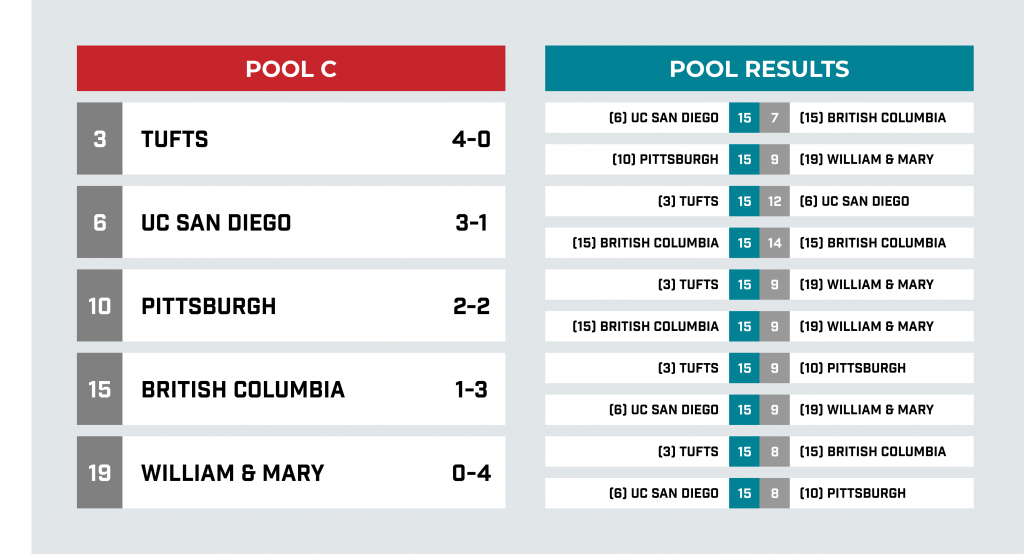
From the first round to the last, Pool C proved to be the most striated of any in the women’s division, featuring mostly lopsided results. Scoreline deficits were higher than in any other pool, and it was the only pool to go perfectly to seed. As such, no. 3 Tufts earned the bye through prequarters and looked like one of the best contenders for the championship.
After a pair of end-to-end blowouts in round one, we were treated to the pool’s best round during the 2:00 PM pairings. On one showcase field, Tufts and UC San Diego battled for what would be the pool-deciding match. A few pitches away, Pittsburgh and British Columbia competed in what wound up as an elimination game.
In the top-seeded matchup, the fans — both in the stands and watching online — were treated to a technical matchup with a variety of defensive looks. In the day’s windiest conditions, the game was dictated by the backfield, as April Weintraub and Margo Urheim steered Ewo through UCSD’s zones, while Samantha Wool, the Hanna twins, and Madison Tenney soaked up touches and guided swings for Dragon Coalition.
UC San Diego kept it close, showing great resilience against a more talented Tufts club. Ewo broke on the game’s first point but gave it back on their next offensive point. With only one more break in the first half, Tufts was up 8-7 at the break. A goal-line block by Olivia Goss staved off a UCSD break to begin the second half, and Tufts converted both that possession and a break on the following point to take a 10-7 lead. It seemed like Ewo might pull away, but Ava Hanna and Pin-Hsuan Chen played key roles in helping get UCSD back to even with a three-goal run. With the wind calming, Urheim asserted herself, crossing over frequently during Tufts’ closing 5-2 run that wrapped the game up with a 15-12 scoreline.
The tone of the clash for the last advancement spot between Danger and the Thunderbirds had a bit of a different tenor. British Columbia built up an early 6-3 lead with a pair of breaks. While Pittsburgh’s aggressive matchup defense was able to generate turns, they usually failed to convert, landing only one break in the first half, while UBC added one more to hold an 8-5 edge. The second half was all holds until Pittsburgh took advantage of a first-throw drop by UBC, breaking to make it 12-11, UBC. But Danger was soon facing their namesake, trailing 14-12 after Delaney Ignatieff got her fourth assist with a break backhand to Anna Goddu.
But Pittsburgh never gave up that game-winning goal to UBC. A clean hold piloted by Linn Bjanes sent the defense on, facing do-or-die. After turns both ways, Pitt’s Madison Pisone smartly jumped an under lane for a poach block, eventually setting up a second-effort grab from Beth Manturuk on a lasered inside break from Jessie Sun, pushing the game to double game point at 14-14. It took three changes of possession, but Danger’s Jessie Chan managed a tough interception in traffic and Bjanes found Sun for the impressive 15-14 come-from-behind victory.
The rest of the pool’s rounds were uneventful. Claire Dunn and Hazel Ostrowski were awesome for Ewo in strong second halves as they outplayed UBC and Pittsburgh on day two. In the pool’s final round, with both teams locked into the bracket, UC San Diego transitioned from a 5-4 lead on Pittsburgh to an 8-5 halftime advantage, which ballooned to 15-8 by the game’s end.
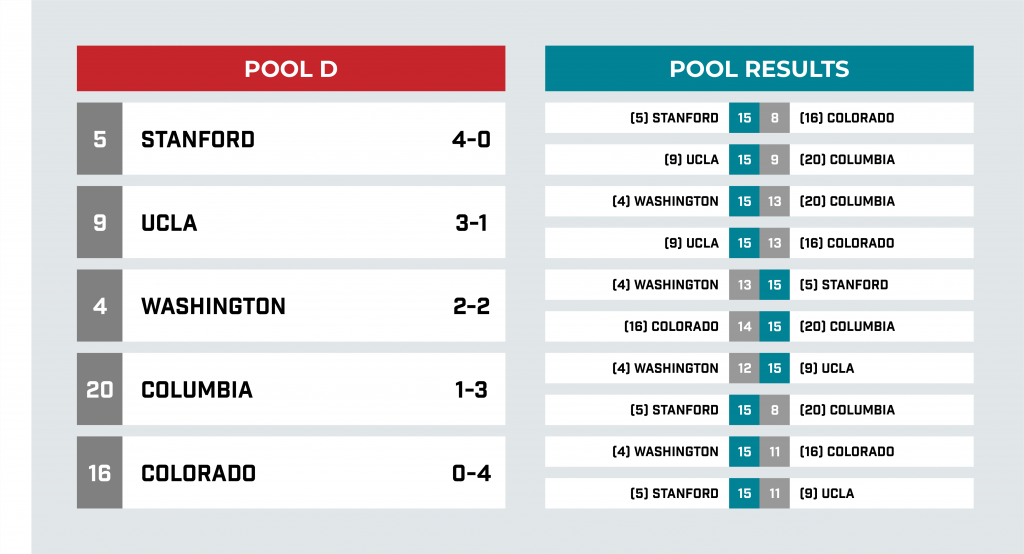
Coming into the tournament, the teams in Pool D knew that this would be a pool of rematches and grudge matches. Every team in this pool — apart from Columbia — attended the Stanford Invite and many of them played each other multiple times despite the shortened regular season. The familiarity proved to be a key factor in a number of wins throughout the pool, and it was clear that smart coaching and discipline won the day, with Stanford, UCLA, and Washington advancing to the bracket.
Pool play was not easy for Washington Element, as the schedule locked them into a contest with Southwest champions Stanford. While Washington had already earned a win over them back in January Superfly had improved as a team since then. In the battle between the top two seeds, it was clear that Washington didn’t quite have their legs under them, dropping the first few points to Stanford in short order. Hallie Dunham and her army of cutters were in sync, while they employed a variety of crushing zones that slowed Washington’s progress. Washington, to their credit, fought back into the game, with Grace Young showing off her versatile two-way game on one pivotal stop.
With Stanford leading 7-5 at half, the coaching core expertly balanced their lines to ensure their roster wouldn’t get fatigued, while still giving ample minutes to their veteran players. On a few defensive points, Stanford took the field with only two handlers, but they still often maintained possession and worked it down to the end zone, earning a break midway through the second half. Washington’s core played well, and earned two breaks of their own in quick succession to get within one once more at 12-11, but some execution errors set them back, allowing Stanford to pull away in the 15-12 win.
Elsewhere in the pool, UCLA dispatched a feisty Columbia team 15-9 thanks to the deep threats of Stephanie Yen and Charlotte Terrasson. Columbia wasn’t able to shut down both of them at the same time, giving plenty of room for the BLU handlers to fire off deep shots into open space. Pandemic eventually threw a zone to try and stop UCLA, but while that slowed BLU’s cutters, it let Erin Doyle loose, and she threw four of UCLA’s seven assists in the second half, eventually emphatically capping the game 15-9 with a hammer to the back corner of the end zone. It wasn’t all bad news for Columbia, though, their offense was sharp, and Aviva Weinbaum was deadly with the disc in hand. Most of UCLA’s in-game adjustments were to stop Weinbaum, which gave Melanie Sawyer plenty of time to shine, too.
Columbia’s luck wouldn’t change, as they faced a steaming Washington team that was ready to prove a point after losing to Stanford. The women of Seattle stormed through the game, with Abby Hecko and Alexa Yadama picking up six assists and three goals between the two of them. Emma Pua’a also had a breakout performance, earning two blocks, a goal, and an assist. No matter how hard Washington fought, Columbia kept pushing back, Julia Simmons had two blocks and two goals, both of which were breaks, and by the end Washington was only able to emerge by the skin of their teeth, winning 15-13.
Friday finished out with UCLA emerging victorious over a Colorado squad that never had a chance to get going. It was UCLA’s second game of the day and they were fully warmed up for their match against Quandary, taking an early lead thanks to the defensive efforts of Malia Smith and Anna Reed. Riley Swift and Bailey Shigley helped them fight back into it, but the late game eventually became a war of attrition, where UCLA’s zone defense proved very effective. Colorado had one chance late, with ULCA holding a slim 14-13 lead, but a heroic block from Malia Smith saved the break, and BLU scored soon after.
Saturday started off with two upsets, as UCLA’s well-coached squad played into Washington’s nightmares and managed to beat Element in very much the same way as Stanford had the day before. While both teams were matched on offense, UCLA’s multiple zone looks proved to be the edge they needed to take a lead late in the game. With everything on the line, Steph Phillips threw a hail mary pass to Abby Hecko, which would have tied the game if a controversial pick call was not upheld. With that change in momentum throwing off Washington’s rhythm, a surprising drop from a cutter popping into the cup cost them their chance to tie the game, and UCLA’s Erin Doyle rifled a pass into the end zone for Stephanie Yen, completing the upset.
On the next field over, Columbia’s impressive tournament display continued with a come-from-behind victory over Colorado, where Columbia trailed the entire game until soft cap. Pandemic struggled early, allowing Quandary to take a 5-2 lead to start. The Metro East women would get back within one point thanks to some death-defying blocks from Liz Thomas, but they squandered it on offense almost immediately after, allowing Colorado to take half 7-4. From there, Colorado’s offense put on a masterclass of patience and confidence, taking shots deep only when needed and using Stacy Gaskill like a cleaver. Sarah Nadler also stepped up on the offense in the second, as Swift went down with an ankle injury. Still, Columbia held their own as best they could, but by the time cap went off, Colorado was ahead 14-11.
From there, it became the Pandemic show. After notching a quick goal on offense, Lily Sickles carried over to the defensive unit, and made a surprise layout stop right next to the goal line for a break. A stunned Colorado offense took to the line on the next point, but conceded another break. Colorado had all but sealed the game before a wide upline pass sailed just too far for Bailey Shigley, whose layout landed out of bounds, giving Columbia the disc. With the game on the line, Weinbaum off an upline pass that capped off a disciplined possession for the win.
The rest of Saturday happened without much fanfare. Stanford dispatched a tired Columbia team that had spent all of their energy to beat Colorado and had no rest in between games, resulting in a 15-8 win for Superfly that wasn’t as close as the score would suggest. Washington beat a Colorado squad in much the same way. And despite a strong first half for UCLA, Stanford pushed past their Southwest compatriot by controlling the flow of the game in the second half.
Previously, we had no half time, but that has been included in this version. ↩
